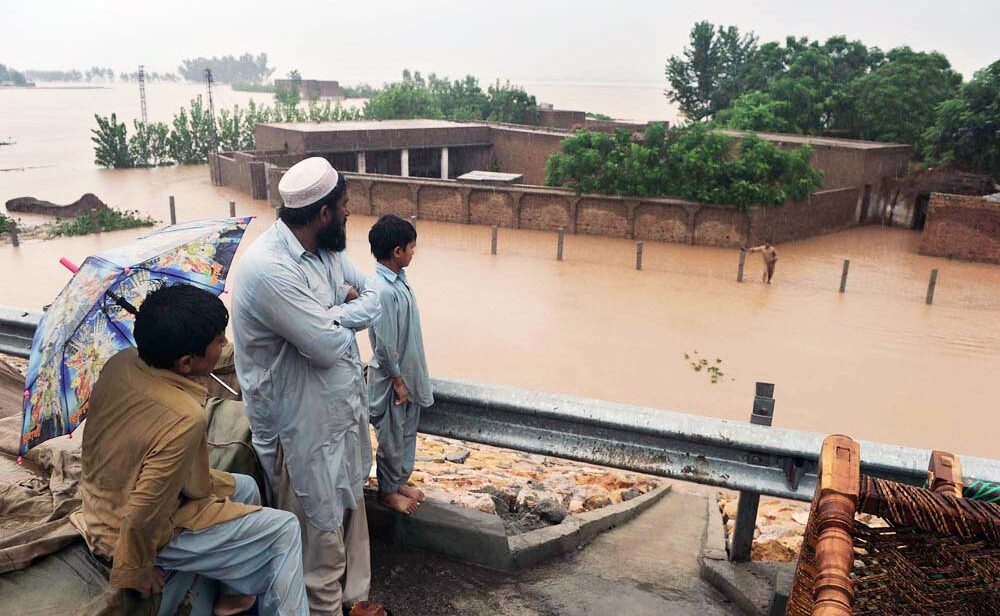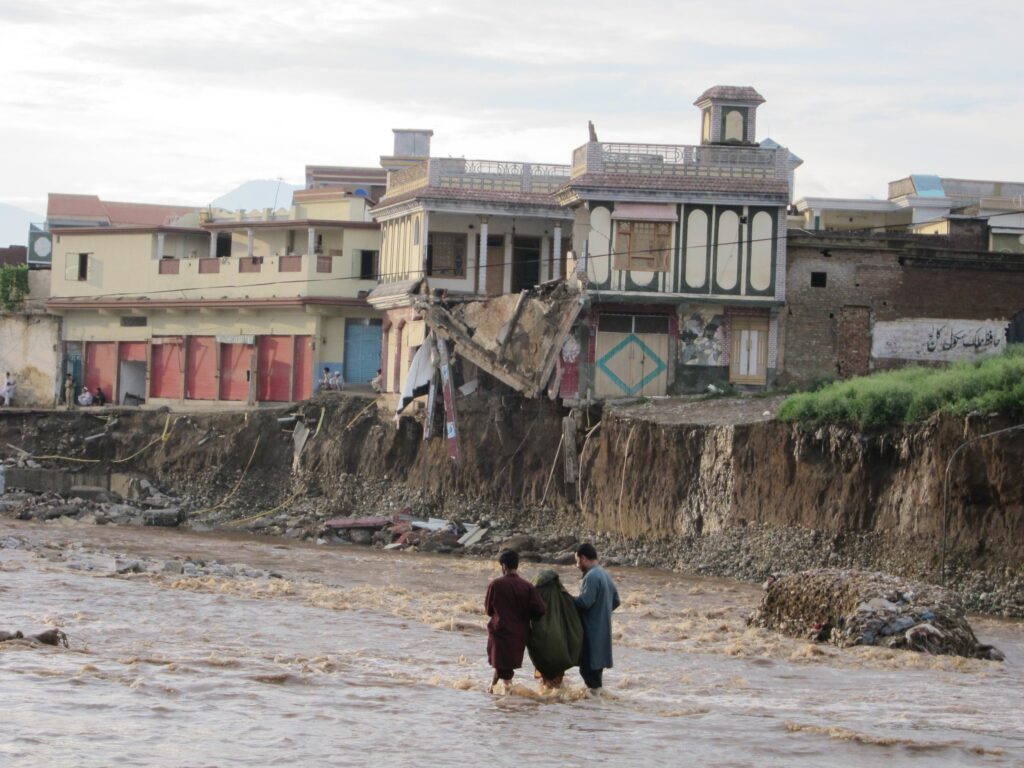
The ongoing floods in Pakistan devastated communities and the country’s infrastructure and economy. The rising frequency of floods, extreme rainfall, and heatwaves has moved climate change from a theoretical discussion point to a palpable burden on the country and its people. From a human perspective, the losses are too grave to quantify. But in political terms, they speak to the missing domain of climate security in the state’s national security architecture, which could pose existential challenges for Pakistan.
Between 2010 to 2022, on average, there has been a major flood every other year in Pakistan, causing hundreds of casualties. The International Panel on Climate Change (IPCC) has projected more frequent and severe extreme weather events. This summer, Pakistan experienced fatal heatwaves and unprecedented monsoon downpours that led to floods. With the world’s current level of action against global warming, precipitation-related disasters such as floods are 2.7 times more likely, and heat-based events such as heatwaves are 5.6 times more likely. One may infer from the IPCC’s projections that the frequency of similar disasters could more than double over the coming decade, with socioeconomic losses piling up to unforeseen levels.
Climate change’s impacts are pervasive and multisectoral, meaning that socioeconomic losses lead to an added burden on the state’s resources and security. Geopolitical foes no longer remain the only threat but just one of a myriad of factors that may now threaten the state. National security must now be viewed through comprehensive security and climate security frameworks to identify the most pressing and existential threats facing Pakistan.
Framework to Analyze Climate Change Threats
Pakistan’s recent National Security Policy (NSP) introduced a “comprehensive national security” framework that embodied the essence of the Comprehensive Security Framework by the Copenhagen School. The National Security Division, which released the policy, is not active in the same way anymore. However, the policy was a valuable step because it broadened Pakistan’s security framework by adding societal, political, economic, and environmental sectors as areas of national security—while retaining the existing importance of military and defense. The NSP’s broadening of traditional security paradigms makes it evident that extreme climate events—such as floods—can threaten state security and the state itself. There remains a need for continued action to expand on the NSP’s positive precedent through more vociferously integrating climate security within Pakistan’s existing national security architecture.
The 2022 floods have displaced entire communities, ended livelihoods and income streams, and increased already high internal migration and urbanization levels.
Climate security demonstrates the interplay between climate change and various security sectors. At its core, climate security looks at the threats, risks, and impacts of climate change at multiple levels and across various fields. The common understanding is that climate security addresses the exacerbation of existing fault lines, which then cause security and conflict-related situations. This is known as the threat multiplier effect of climate change. However, the threat multiplier effect is not the only effect of severe climate change-induced events because they pose direct threats to different sectors of security.
A Multisectoral Threat to Comprehensive National Security
Pakistan’s ongoing floods are not a normal occurrence. Balochistan, one of the most affected provinces, is known to be arid, deprived of rainfall, and often struck with droughts. This monsoon season, however, Pakistan’s Meteorological Department reported that Balochistan experienced 371 percent higher rainfall, causing flash floods and significant humanitarian losses. Current estimates show that over 33 million people have been affected, with over a thousand people paying the ultimate price (so far). While quantifiable economic damages will come with time, the 2010 floods—considered less severe than the 2022 floods—cost roughly $43 billion in economic damages. These economic costs will only rise as the frequency of extreme climate events increases.

While economic losses can be quantified, climate catastrophes also impact societal and political cohesion. The 2022 floods have displaced entire communities, ended livelihoods and income streams, and increased already high internal migration and urbanization levels. Suppose relief efforts are not comprehensive and affected communities feel they have not been provided for after a calamity they did not induce. In that case, their belief in the legitimacy or governing authority of the state could be adversely impacted, creating downstream risks of mass unrest. Individually, peoples’ sense of self remains in constant flux every time there is an extreme climate catastrophe. Destroyed inter-generational homes, internal displacement, and camp-like makeshift arrangements will pose significant identity-based challenges and create socioeconomic insecurities among affected communities. Such effects severely damage the societal and political sectors of security, undermining national cohesion.
Furthermore, extreme weather events account for short-term disaster relief and long-term strain on state resources. With greater displacement, poverty and unemployment rates go up as more people lose breadwinners or become climate refugees. Violence against women tends to increase as does the risk of human trafficking. Children drop out of school, particularly young girls, as infrastructure is damaged. People have less access to food and clean water, disease rates go up, and quality of life declines—all of which are multisectoral concerns.
Expending military resources to HADR will naturally take away from responding to other crises and potentially inhibit the military’s function of protecting Pakistan’s borders.
Another indirect threat is to the military. The military has played an active and comprehensive role in Humanitarian Assistance and Disaster Relief (HADR) for flood-affected areas. The military has lost high-ranking officials, including Commander 12 Corps (a Lieutenant General), while overseeing relief activities in the Lasbela district in Balochistan. Given the increased likelihood estimates from the IPCC reports, Pakistan’s HADR requirement will only increase over time. Expending military resources to HADR will naturally take away from responding to other crises and potentially inhibit the military’s function of protecting Pakistan’s borders.
Moving Forward
Pakistan’s comprehensive national security is threatened by the negative impacts of extreme weather events across various sectors. It is not just about economic security versus traditional security anymore. National security can never be one or the other because national power consists of all elements and resources that provide the state with the ability to pursue its interests. Thus, all those elements, resources, and sectors form a part of its security. As a result, to address the entire gambit of multi-sectoral threats, a comprehensive view of national security is required with equal focus on all sectors, while prioritizing climate security due to its severity and immediacy. The NSP began this conversation officially, but its focus on the environmental sector was not adequate given the seriousness of its threat to national security. Primarily, this is due to a narrow focus by policymakers regarding the threats from climate change, such as considering its impact on food, water, and energy security alone without evaluating the threat potential on other sectors. As a result, climate change is not viewed as an existential threat to the state. However, as the threats from climate change induced disasters continue to increase it will be essential to implement concrete policies which are focused on addressing climate change’s multisectoral impact.
Moving forward, Pakistan might need to reconsider the way it perceives climate change and climate action on a political level. Developing an interdisciplinary perspective is vital to address the needs of the people directly affected by the climate crisis. Practically, this can translate into holistic stakeholder engagement, functional accountability mechanisms, or even integrating climate action into government operations. Moving beyond planning and strategizing to address climate change’s adverse impacts and security threats, driving implementation will be the key to ensuring constructive outcomes. Policy implementation has to be sector-specific since climate action in the societal and political sectors could be different from the requirements for the economic or military sector. The government should follow the NSP model and engage public and private stakeholders in all security sectors to create a sector-specific climate security threat profile for the country. Implementation must then be driven by each sector’s own stakeholders while focusing on mitigating climate vulnerability and enhancing climate adaptation.
***
Click here to read this article in Urdu.
Image 1: Irin Photos via Flikr
Image 2: Oxfam International via Flikr